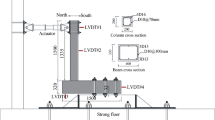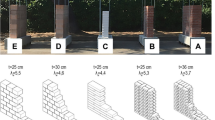Abstract
This paper reports the results of an investigation on the behaviour of axially loaded joints utilising glued-in steel rods. A finite element model has been set up, in order to study the most influencing parameters for the shear stress distribution. Then, a series of tests have been carried out on joints made with Norway Spruce blocks and threaded steel bars, with different epoxy resin formulations and various ratios of hole/bar diameters. Different bar diameters have been used in experimental survey, ranging from 8 to 12 mm. Clearances of 1 or 2 millimetres have been left between bar and hole wall. The reported results are based on a sample of 240 specimens, which can be considered sufficient for statistical reliability. A statistical analysis has been performed, which confirms that: 1) the system proved to be highly efficient and reliable, with regard both to failure load and to joint stiffness; 2) with the epoxy-based adhesive used, the most important parameters affecting the strength and the stiffness of these joints seem to be the thickness of glue line and the viscosity property of the adhesive during the pouring phase; 3) these kinds of joints can be designed as ductile for specific purposes, choosing a suitable diameter of the bar.
Zusammenfassung
Diese Arbeit berichtet über die Ergebnisse einer Untersuchung über axial belastete Verbindungen mit eingeklebten Stahlstäben. Ein FE-Modell wurde aufgestellt, um die wichtigsten Parameter für die Verteilung der Scherbelastung zu untersuchen. Anschließend wurde eine Reihe von Tests an Verbindungen aus norwegischer Fichte und Gewindestäben aus Stahl mit verschiedenen Epoxitharzen und unterschiedlichem Loch/Stabdurchmesser durchgeführt. Verschiedene Stabdurchmesser, von 8 bis 12 mm, wurden in dieser experimentellen Untersuchung herangezogen. Der Freiraum zwischen Stange und Lochwand betrug 1 oder 2 mm. Die genannten Ergebnisse basieren auf einem Kollektiv von 240 Proben, was als statistisch ausreichend angesehen werden kann. Eine statistische Analyse wurde durchgeführt, die bestätigt: 1) das System erwies sich als hochgradig zuverlässig, sowohl im Hinblick auf Bruchlast als auch auf Verbindungsfestigkeit, 2) mit der Verwendung des Epoxitklebers scheinen die wichtigsten Parameter im Bezug auf Festigkeit und Unbeweglichkeit die Dicke der Klebefuge und die Viskosität des Klebers während der Bearbeitung zu sein, 3) dieser Verbindungstyp kann für bestimmte Anwendungsgebiete als duktil gestaltet werden, es muss nur ein passender Stabdurchmesser gewählt werden.




















Similar content being viewed by others
References
Aicher S, Dill-Langer G (2001) Influence of moisture, temperature and load duration on performance of glued-in rods. In: Proceedings, Rilem PRO, Stuttgart, Germany, September 2001, pp 383–392
Ballerini M, Piazza M, Zanon P (1994) Static and cyclic behaviour of glued joints in timber. In: Proceedings, P.T.E.C. 94, Gold Coast, Australia, pp 2.811–2.81
Bengstsson C, Johansson CJ (2001) Girod-glued-in rods for timber structures. In: Proceedings, CIB-W 18/34-7-8, Meeting thirty-four, Venice, Italy
Bengtsson C, Kemmsies M, Johansson C (2000) Production control methods for glued-in rods for timber structures. In: Proceedings, W.C.T.E. 2000 Whistler B.C. (Canada), p 7.4.1
Blass HJ, Laskewitz B (2001) Load-carrying capacity of axially loaded rods glued-in perpendicular to the grain. In: Proceedings, Rilem PRO, Stuttgart, Germany, September 2001, pp 363–371
Bodig J, Jayne BA (1982) Mechanics of wood and wood composites. Van Nostrand, New York
Buchanan AH, Deng XJ (1996) Strength of epoxied steel rods in glulam timber. In: Proceedings, I.W.E.C., New Orleans, Louisiana, USA, 4:488–495
Del Senno M, Piazza M, Tomasi R (2001) Behaviour analysis of axially loaded glued-in timber-steel joints. In: Proceedings, the IABSE Conference “Innovative Wooden Structures and Bridges”, Lahti 2001
Deng JX, Moss PJ, Buchanan AH (1998) Glued bolts in glulam—an analysis of stress distribution. In: Proceedings, W.C.T.E. 1998, Montreux, Switzerland, 4:206–210
DIN 1052 Entwurf (2000) Entwurf, Berechnung und Bemessung von Holzbauwerken
Final draft pr EN 1995-1-1 Eurocode 5 (2001) Design for timber structures. Part 1.1 General rules and rules for buildings
Gustafsson PJ, Serrano E (2001) Glued-in rods for timber structures—development of a calculation model. Technical report for WP1, Project SMT4_CT97:2199 (GIROD)
Lavisci P, Berti S, Pizzo B, Triboulot P, Zanuttini R (2001) A shear test for structural adhesives used in the consolidation of old timber. Holz Roh- Werkstoff 59:(1/2):145–152
Piazza M, Ballerini M, Ferrari A (1998) Plane grid glulam structures: development of moment resistant connections with glued-in steel rods. In: Dubina D, Vagas I, Ungureanu V (eds) New technologies and structures in civil engineering—case studies on remarkable constructions, Editura Orizonturi Universitare Timisoara, ISBN 973-9400-40-X, pp 121–144
Ranta-Maunus A, Kangas J (1994) Glue-in steel rods in v-shape. In: Proceedings, Pacific Timber Engineering Conference, Gold Coast, Australia 2:778–784
Riberholt H (1986) Glued bolts in glulam—part I. Department of Structural Engineering, Technical University of Denmark, Series R, n. 210, 1986
Riberholt H (1988) Glued bolts in glulam—part II. Department of Structural Engineering, Technical University of Denmark, Series R, n. 210, 1988
Serrano E (2001) Glued-in rods for timber structures—an experimental study of softening behaviour. Mater Struct 34:228–234
Volkersen O (1938) Die Nietkraftverteilung in zugbeanspruchten Nietverbindungen mit konstanten Laschenquerschnitten. Luftfahrtforschung 15:41–47
Author information
Authors and Affiliations
Corresponding author
Rights and permissions
About this article
Cite this article
del Senno, M., Piazza, M. & Tomasi, R. Axial glued-in steel timber joints—experimental and numerical analysis. Holz Roh Werkst 62, 137–146 (2004). https://doi.org/10.1007/s00107-003-0450-1
Published:
Issue Date:
DOI: https://doi.org/10.1007/s00107-003-0450-1




